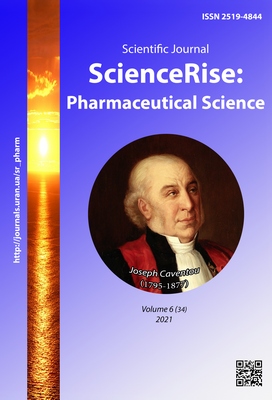Results of public assessment of influence factors on the formation of the brand of the institution of higher education in the pharmaceutical direction
DOI:
https://doi.org/10.15587/2519-4852.2021.248050Keywords:
brand, formation, assessment, results, factors of influence, institution of higher education, publicAbstract
The aim of the article is to study the attitude of target audiences to the brand of a higher education institution, taking into account the specifics of the educational services provided to them and the specifics of the educational services market.
Methods of the research: theoretical (analysis and synthesis of scientific literature and normative sources, generalization, analytical, comparative and logical), empirical (descriptions, comparison, questionnaires, mathematical and statistical).
Materials: questionnaires of respondents, which were applicants, students, alumni and employees of NUPh.
Results of the research. According to students, the most significant factors are positive reviews about HEI (14 % of respondents), the quality of educational services and the involvement of well-known scientists and practitioners (12 % each), the presence of scientific schools, traditions and the active participation of the institution in public life (11 % each factor). For applicants, an important place is occupied by the state status of a higher education institution, positive reviews about it and high quality of educational services (13 % for each factor). The advantages that graduates of the prestigious HEI have after graduation are a high level of theoretical knowledge (89 % of respondents) and practical skills (85 %), a high level of competitiveness in the labor market (81 %). Among the main directions for the development and improvement of the educational brand, the interviewed NUPh employees noted the constant improvement of the quality of educational services (91 % of the respondents), the intensification of international cooperation (86 %), the active involvement of practitioners and scientists in the scientific, volunteer and cultural life of the institution (79 %).
Conclusions. It has been proven that an important component of the brand of a higher education institution is an educational service; image of educational services; the benefits to be provided by the brand owner to consumers of educational services. The most significant factors of popularity and positive attitude towards NUPh and the advantages received by graduates after graduation have been established. A conclusion was made about the high level of corporate culture in HEI, the important elements of which are the presence of the NUPh development strategy, the introduction of effective management technologies and the creation of conditions for the self-realization of employees
References
- Organisation for economic cooperation and development. Statistics and publications. Available at: www.oecd.org Last accessed: 26.03.2021
- Melewar, T. C., Nguyen, B. (2014). Five areas to advance branding theory and practice. Journal of Brand Management, 21 (9), 758–769. doi: http://doi.org/10.1057/bm.2014.31
- Zamerchenko, N. I. (2012). Branding in Education. IAroslavskii pedagogicheskii vestnik, 2 (2), 79–81.
- Fernandes, T., Moreira, M. (2019). Consumer brand engagement, satisfaction and brand loyalty: a comparative study between functional and emotional brand relationships. Journal of Product & Brand Management, 28 (2), 274–286. doi: http://doi.org/10.1108/jpbm-08-2017-1545
- Vera, J. (2016). Two paths to customer loyalty: the moderating effect of the differentiation level strategy in the performance-satisfaction-value-intentions relationship. Journal of Product & Brand Management, 25 (2), 171–183. doi: http://doi.org/10.1108/jpbm-01-2015-0789
- Mills, A. J., Robson, K. (2019). Brand management in the era of fake news: narrative response as a strategy to insulate brand value. Journal of Product & Brand Management, 29 (2), 159–167. doi: http://doi.org/10.1108/jpbm-12-2018-2150
- Zhadko, E. A., Kapustina, L. M., Romanova, N. Iu. (2016). Pozitsionirovanie i brending obrazovatelnoi organizatsii. Ekaterinburg: Izd-vo Ural. gos. ekon. un-ta, 204.
- Wohlfeil, M., Whelan, S. (2012). "Saved!" by Jena Malone: An introspective study of a consumer's fan relationship with a film actress. Journal of Business Research, 65 (4), 511–519. doi: http://doi.org/10.1016/j.jbusres.2011.02.030
- Kandampully, J., Zhang, T., Bilgihan, A. (2015). Customer loyalty: a review and future directions with a special focus on the hospitality industry. International Journal of Contemporary Hospitality Management, 27 (3), 379–414. doi: http://doi.org/10.1108/ijchm-03-2014-0151
- Maity, M., Gupta, S. (2016). Mediating Effect of Loyalty Program Membership on the Relationship Between Advertising Effectiveness and Brand Loyalty. Journal of Marketing Theory and Practice, 24 (4), 462–481. doi: http://doi.org/10.1080/10696679.2016.1205450
- Garipağaoğlu, B. Ç. (2015). Branding in Higher Education: A Case Study from Turkey. Higher Education Policy, 29 (2), 254–271. doi: http://doi.org/10.1057/hep.2015.24
- Alikperov, I. M., Zhadko, E. A., Timokhina, G. S. (2016). Model upravleniia brendom obrazovatelnoi organizatsii. Ekonomika i predprinimatelstvo, 11, 474–477.
- Hwang, J., Kandampully, J. (2012). The role of emotional aspects in younger consumer‐brand relationships. Journal of Product & Brand Management, 21 (2), 98–108. doi: http://doi.org/10.1108/10610421211215517
- Kotvitska, A. A., Yakovlieva, O. Y. (2021). The study of the theoretical approaches to the event management in order to form the brand of a higher education institution. Social Pharmacy in Health Care, 7 (2), 4–9. doi: http://doi.org/10.24959/sphhcj.21.225
- National University of Pharmacy. Available at: https://nuph.edu.ua/
- Gong, T. (2017). Customer brand engagement behavior in online brand communities. Journal of Services Marketing, 32 (3), 286–299. doi: http://doi.org/10.1108/jsm-08-2016-0293
- Bakasova, O. A. (2016). The impact of social expectations of students with regard to the university brand on de-velopment of academic motivation. Business. Education. Law. Bulletin of Volgograd Business Institute, 1 (34), 264–268.
- Hollebeek, L. D., Glynn, M. S., Brodie, R. J. (2014). Consumer Brand Engagement in Social Media: Conceptualization, Scale Development and Validation. Journal of Interactive Marketing, 28 (2), 149–165. doi: http://doi.org/10.1016/j.intmar.2013.12.002
- Alikperov, I. M., Zhadko, E. A., Timokhina, G. S. (2016). Model upravleniia brendom obrazovatelnoi organizatsii. Ekonomika i predprinimatelstvo, 11-2 (76-2), 474–477.
- Dudarev, O. K., Kustitskaia, T. A., Ovchinnikova, E. V. (2016). Matematicheskaia statistika. Krasnoiarsk, 156.
- Chang, C.-T., Chu, X.-Y., Tsai, I.-T. (2020). How Cause Marketing Campaign Factors Affect Attitudes and Purchase Intention. Journal of Advertising Research, 61 (1), 58–77. doi: http://doi.org/10.2501/jar-2019-046
Downloads
Published
How to Cite
Issue
Section
License
Copyright (c) 2021 Alla Kotvitska, Alina Volkova, Olena Yakovlieva

This work is licensed under a Creative Commons Attribution 4.0 International License.
Our journal abides by the Creative Commons CC BY copyright rights and permissions for open access journals.








